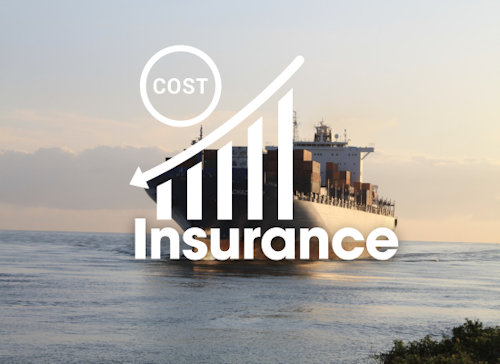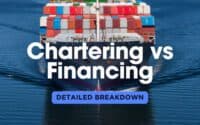20 Proven Ways to Cut Insurance Costs for Ship Owners

In the competitive world of maritime operations, managing costs effectively is crucial for sustainability and growth. Insurance, while essential, represents a significant operational cost for ship and fleet owners. However, with strategic planning and informed decision-making, it’s possible to significantly reduce insurance expenses without compromising on coverage. Here are our top 20 actionable tips designed to help maritime professionals navigate the complexities of insurance, ensuring they not only meet their legal and operational requirements but also maximize their cost efficiencies.
* Please send feedback/suggestions to editor @ shipuniverse.com
1. Opt for Higher Deductibles
Tip: Increase your deductible to lower your premium.
Explanation: By opting for a higher deductible, you take on more risk upfront, but your insurance premiums will decrease. This can result in substantial savings, especially if you maintain a good safety record and encounter fewer claims.
Consideration: Assess your financial ability to handle higher out-of-pocket costs in the event of a claim. This strategy is best for companies with a solid financial foundation and minimal claims history.
2. Bundle Policies
Tip: Bundle multiple insurance policies with the same provider.
Explanation: Many insurers offer discounts when you bundle different types of policies, such as hull insurance, protection and indemnity (P&I), and cargo insurance.
Benefit: This can not only simplify your insurance management but also reduce your overall insurance costs.
Action Step: Review all your current policies and discuss bundling options with your insurance agent to find the best possible rates.
3. Implement Risk Management Programs
Tip: Invest in comprehensive risk management and safety programs.
Explanation: Insurers often provide discounts to ship owners who demonstrate proactive management of risks. This includes regular safety drills, maintenance checks, and investments in safety equipment and training.
Benefit: Apart from lowering insurance premiums, effective risk management reduces the likelihood of incidents that can lead to claims, thereby potentially saving significant amounts in the long run.
Example: Conduct regular training sessions for crew on handling equipment safely and dealing with emergencies.
4. Shop Around and Negotiate
Tip: Regularly shop around for insurance and negotiate with providers.
Explanation: Market conditions and insurance offerings change regularly. By obtaining quotes from multiple insurers, you can leverage competitive offers to negotiate better terms with your current insurer or switch to a more cost-effective provider.
Action Step: Make it a practice to seek new quotes at each policy renewal period and use any favorable market conditions as leverage in negotiations.
Consideration: Ensure that any new insurance offers the same level of coverage and service, as lower premiums should not come at the cost of essential protections.
5. Focus on Crew Training and Certification
Tip: Invest in crew training and certifications.
Explanation: Insurance companies favor ships that are operated by well-trained, certified crews. Demonstrating that your crew has up-to-date training in safety and operations can lead to lower insurance premiums.
Benefit: A skilled and certified crew not only minimizes the risk of accidents but also enhances the operational efficiency of your ships.
Action Step: Regularly enroll your crew in training programs and obtain certifications that are recognized by insurance providers.
6. Utilize Technology for Safety and Efficiency
Tip: Integrate advanced navigation and safety technologies.
Explanation: Technologies such as AIS (Automatic Identification Systems), advanced radar systems, and electronic chart display and information systems (ECDIS) can significantly mitigate risks by enhancing navigational safety.
Benefit: Insurers often provide discounts for vessels that incorporate technology to prevent accidents and improve tracking.
Example: Installing collision avoidance systems can reduce the risk of at-sea incidents, thereby potentially lowering your insurance rates.
7. Maintain a Good Loss History
Tip: Keep a detailed and transparent loss history.
Explanation: A clean loss history can be one of your best tools in negotiating lower insurance premiums. Consistently low or zero claims over an extended period show an insurer that your risk level is lower.
Benefit: Ship owners with a positive loss record often receive better rates and more favorable terms.
Action Step: Ensure that all incidents, even minor ones, are properly documented and reported, and work towards minimizing repeat incidents.
8. Review and Adjust Valuations Regularly
Tip: Regularly review and adjust the insured values of your vessels.
Explanation: The market value of ships can fluctuate due to factors like market demand, age, and condition. Over-insuring (or under-insuring) can lead to inappropriate premium levels.
Benefit: By adjusting the insured values to more accurately reflect current market conditions, you can avoid paying for excessive coverage.
Action Step: Conduct annual reviews of your fleet’s valuation and discuss these valuations with your insurance provider to ensure your coverage reflects the true replacement or repair cost.
9. Choose the Right Insurance Broker
Tip: Partner with a broker who specializes in maritime insurance.
Explanation: A knowledgeable broker can provide invaluable assistance in navigating the complex world of maritime insurance. They can help identify the best policies for your specific needs and assist in negotiations with insurers.
Benefit: Experienced brokers often have strong relationships with insurers and can secure more favorable terms or find policies that offer better value.
Action Step: Select a broker with a proven track record in the maritime sector and review their performance periodically to ensure they continue to meet your needs.
10. Opt for Lay-up Credits
Tip: Take advantage of lay-up credits when ships are inactive.
Explanation: If a vessel is not in use for an extended period, insurers may offer a reduction in premiums, known as lay-up credits, because the risk of accidents or claims is reduced.
Benefit: This can lead to significant cost savings, especially for larger fleets or during off-season periods.
Action Step: Inform your insurer when a vessel will be inactive and provide proof of lay-up to qualify for these credits.
11. Regularly Update Safety Equipment
Tip: Ensure that all safety equipment on board is up to date and in good working condition.
Explanation: Insurers assess the condition and age of safety equipment when determining risk levels. Modern, well-maintained equipment can lower the perceived risk, leading to lower premiums.
Benefit: Updated safety equipment not only contributes to lower insurance costs but also improves overall safety on board, reducing the likelihood of accidents.
Example: Regular checks and upgrades of life-saving appliances, fire-fighting equipment, and pollution prevention gear are essential.
12. Engage in Active Claims Management
Tip: Develop a proactive approach to managing and settling claims.
Explanation: Effective claims management involves timely reporting, thorough documentation, and active involvement in the settlement process. This can help expedite claims resolution and prevent increases in future premiums due to unresolved claims.
Benefit: Quick and efficient claim handling can prevent larger losses and demonstrate to insurers that your risk management processes are robust.
Action Step: Train your team on the importance of immediate and accurate incident reporting and ensure they understand the claims process.
13. Emphasize Environmental Compliance
Tip: Ensure strict adherence to environmental regulations.
Explanation: Insurance companies often offer lower premiums to vessels that comply with the latest environmental standards, as this reduces the risk of costly penalties and damage claims related to environmental incidents.
Benefit: Compliance not only helps in reducing insurance costs but also enhances your reputation in the industry, potentially leading to more business opportunities.
Action Step: Regularly review and update your practices to stay in line with the latest MARPOL and other relevant environmental regulations.
14. Leverage Fleet Experience
Tip: Highlight the experience and track record of your fleet.
Explanation: Insurers take into account the operational history of your ships. A fleet with a long track record of safe operations usually qualifies for lower premiums compared to a newer fleet with less operational history.
Benefit: Demonstrating a long-standing commitment to safety and efficient operations can substantially lower your insurance rates.
Action Step: Prepare and maintain detailed operational records and present these as evidence of your fleet’s reliability and safety during insurance negotiations.
15. Optimize Insurance Scope Based on Risk Assessment
Tip: Tailor your insurance coverage based on a detailed risk assessment.
Explanation: Not all risks require the same level of coverage. By conducting a thorough risk assessment, you can determine where you might need more comprehensive coverage and where you can safely reduce it.
Benefit: This targeted approach prevents over-insuring and under-insuring, ensuring you pay only for the coverage you actually need.
Example: Assess risks such as piracy, which might be higher in certain areas, and adjust your coverage accordingly when your ships operate in those regions.
16. Encourage a Safety Culture Among Crew
Tip: Foster a strong safety culture onboard all vessels.
Explanation: A safety-oriented crew is less likely to engage in behavior that leads to accidents or insurance claims. Regular training, clear safety protocols, and incentives for safe behavior can cultivate this culture.
Benefit: Insurers often recognize the value of a strong safety culture and may offer discounts to fleets that demonstrate a commitment to continuous safety improvements.
Action Step: Implement regular safety meetings, continuous training programs, and recognition for exceptional safety performance among crew members.
17. Review and Revise Coverage Annually
Tip: Conduct an annual insurance review to ensure coverage is still appropriate for your needs.
Explanation: The maritime industry is dynamic, and your insurance coverage should reflect changes in your fleet, operations, and the regulatory environment. An annual review helps identify any coverage gaps or excesses.
Benefit: Adjusting your insurance annually can prevent costly premiums for unnecessary coverage and ensure you are adequately protected against current risks.
Action Step: Set a regular schedule with your insurance broker to review and adjust your policies.
18. Engage in Loss Prevention Initiatives
Tip: Participate in loss prevention initiatives offered by insurers.
Explanation: Many insurance companies provide programs designed to help ship owners reduce the risk of losses through improved practices and technologies. Participation in these programs can often lead to premium discounts.
Benefit: Besides saving on premiums, these initiatives improve overall fleet safety and operational efficiency.
Example: Join programs focusing on fire safety improvements, which can significantly reduce the risk of one of the most common and costly types of maritime incidents.
19. Consolidate Insurance Providers
Tip: Consolidate your insurance policies with fewer providers.
Explanation: Working with fewer insurers for multiple coverage needs can simplify management and increase your bargaining power for better rates.
Benefit: Consolidation often leads to cost savings through loyalty discounts and reduced administrative overhead.
Action Step: Evaluate the benefits and coverage of all current providers and consider moving all policies to the one that offers the best overall value.
20. Monitor and Manage Crew Health
Tip: Implement comprehensive health monitoring and wellness programs for your crew.
Explanation: Healthy crew members are less likely to be involved in accidents or incidents that lead to insurance claims. Programs that promote physical and mental health can reduce medical claims and lost time due to sickness.
Benefit: Insurance providers may offer lower premiums for fleets that demonstrate a proactive approach to crew health.
Action Step: Establish routine health checks, mental health support programs, and fitness incentives for crew members.
Implementing these money-saving insurance strategies requires a proactive approach to risk management and a deep understanding of the maritime insurance landscape. By regularly reviewing and adjusting insurance policies, fostering a strong safety culture, and engaging with experienced brokers, ship and fleet owners can secure substantial savings. These savings not only enhance financial performance but also contribute to the overall resilience and competitiveness of their maritime operations. As the industry continues to evolve, staying informed and adaptable is key to maintaining optimal insurance coverage at the most reasonable cost.

Do you have a Maritime Product or Service that may be of interest to Shipowners? Tell us about it here!
Do you have feedback or insights? Please reach out to editor @ shipuniverse.com



